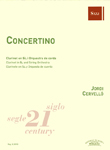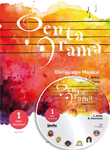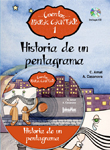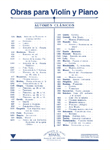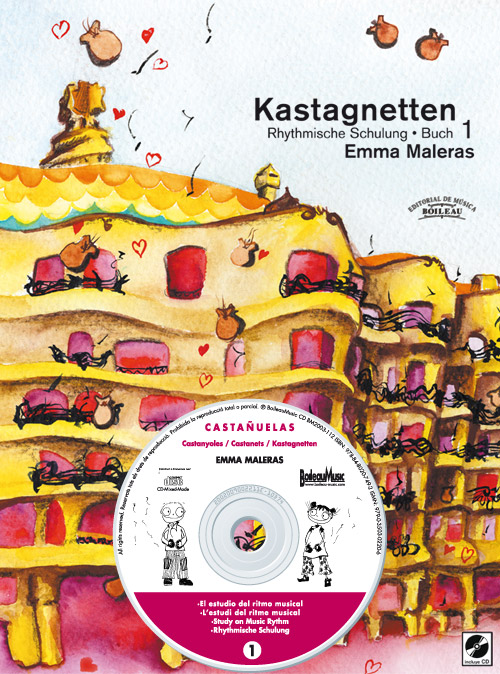KASTAGNETTEN - Buch 1
Rhytmische Schulung
Castañuelas
MALERAS, EmmaReg.: B.3337
21,00 €
P.V.P. (VAT included 4%)
Add to cart
- Review: GRAU, Consol
- Ensemble: Solo.
- Genres: Musical education: Instrumental study repertoire; Instrument methods.
- Language: Alemán
- Product format: Partituras + CD / DVD
- Difficulty level: Elementary
- Period: 2nd half S. XX - XXI
- Publishing house: Editorial Boileau
- Collection: Maleras
- Illustrator: FORNER, Ester
- No. of pages: 44
- Measure: 29,50 x 21,00 cm
- ISBN: 978-84-8020-752-2
- ISMN: 979-0-3503-0225-1
- Available in digital: No
- Available for rent: No
There is no doubt that Emma Maleras knows a great deal about everything to do with the study of rhythm. Having learned music by first studying the piano and then, in particular, by studying flamenco dance and learning to play the castanets, she has spent more than thirty years of her career teaching the castanets to several generations of pupils.
This extensive experience has helped her to create a teaching method that she has perfected throughout her teaching career. She now presents her method in this series of books, the aim of which is for pupils to achieve true rhythmic accuracy through their reading, as a separate discipline from learning to play an instrument in tune.
Due to their small size and sharp, dry sound, castanets are ideal for studying rhythm and they have proved to be useful for beginners of all ages.
By practising with these books pupils will gradually learn how rhythm works, studying aspects such as accents, measures, the values of notes and rests, as well as syncopation and tied notes. Pupils will get used to the different beats on which to come in: in time, off beat, on the up-beat and acephalous. All the studies and exercises in the collection are accompanied by music by classical composers and popular tunes, which make it enjoyable and pleasant to practise, despite the slow metronome beat that is used during the earlier lessons. These accompaniments are included on the Audio CD that comes with the book.
It is also very useful for Dance students to play the castanets, as it will quickly help them to learn the necessary accuracy of movement that this discipline requires. Instrumentalists in general will also gain a great deal from studying the castanets, as they strengthen the fingers due to the movement of the 3rd finger, as well as giving the ring finger and little finger considerable independence. Constant castanet work also has proven therapeutic properties, both as a prevention and as a cure.
In short, this method, which has been created and developed by Emma Maleras, helps to raise the profile of the castanets and emphasises all their benefits for music students, as well as promoting the beauty of their sound as a solo instrument, which is admired all over the world.
RATSCHLÄGE
EINFÜHRUNG
KASTAGNETTEN. Rhythmische Schulung
EINFÜHRUNG in die Notenschrift für Kastagnetten
1. Das Bigramm
2. Die Nummerierung der Finger
3. Die Finger 3 und 7
MUSIKTHEORIE und Grundkenntnisse des musikalischen Vokabulars
4. Die Notenwerte
5. Die Pausen
6. Die Taktarten
7. Die Pausentakte
DIE KASTAGNETTEN UND DU. Handhabung und Befestigung des Instruments
8. Körperhaltung beim Üben
9. Mit Kraft angeschlagene Noten
Elf tägliche Übungen der Noten mit Kraft angeschlagen
10. Der Zweivierteltakt (2/4)
Ausführung der metrischen Betonung im Zweivierteltakt
Fünf Übungen zur Ausführung der metrischen Betonung im Zweivierteltakt
Übung der halben Note im Zweivierteltakt
Musikstück 1 (Übung der halben und Viertelnote im Zweivierteltakt): La pastoreta und El ball de St. Ferriol
11. Der Viervierteltakt (4/4)
Ausführung der metrischen Betonung im Viervierteltakt
Fünf Übungen zur Ausführung der metrischen Betonung im Viervierteltakt
Übung zur Ausführung der ganzen Note
Übung zur Ausführung der halben Note im Viervierteltakt
Musikstück 2 (Ausführung der 4 Zeiten, die einer ganzen Note entsprechen): Sonatina Op. 36 Nr.1
12. Der Dreivierteltakt (3/4)
Metrische Betonung im Dreivierteltakt
Sechs Übungen zur Ausführung der metrischen Betonung im Dreivierteltakt
Musikstück 3 (Übung der halben und Viertelnoten im Dreivierteltakt): Mazurka Op. 7 Nr.1
13. Die Coda
Musikstück 4 (Ausführung der halben und Viertelnoten im Zweivierteltakt, mit Fingerwechsel nur bei den Viertelnoten): Annenpolka Op. 117
Musikstück 5 (Ausführung der halben und Viertelnoten im Zweivierteltakt mit Wechsel der Fingernummerierung): Mit Freude durch die Welt
14. Der Verlängerungspunkt
Übung zur Ausführung der punktierten halben Note
Zwei Übungen im Viervierteltakt mit verschiedenen Figuren
usikstück 6 (Ausführung der halben, punktierten halben und Viertelnoten): Menuett
15. Die Fermate
Musikstück 7 (Ausführung aller Notenwerte, die in diesem Buch gelernt wurden): Stefania-Gavotte
VORBEREITUNG FÜR DAS ZWEITE BUCH
Fünf Übungen zur Ausführung der Achtelnote
VERZEICHNIS DER STÜCKE AUF DER CD


